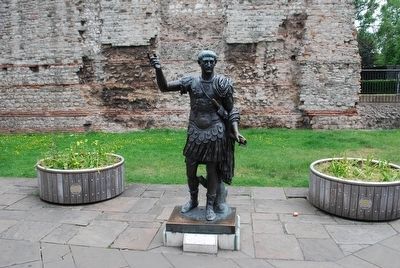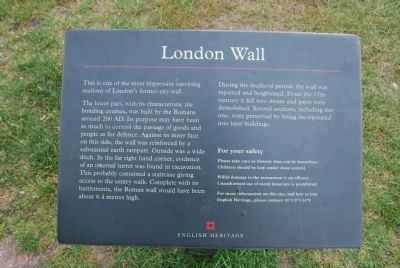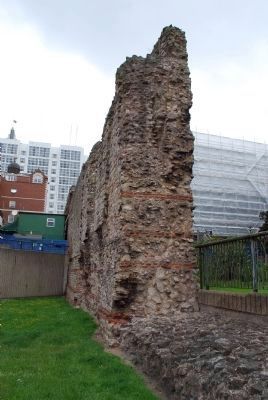Tower Hamlets in Greater London, England, United Kingdom — Northwestern Europe (the British Isles)
London Wall
This is one of the most impressive surviving section of London's former city wall.
The lower part, with its characteristic tile bonding courses, was built by the Romans around 200 AD. Its purpose may have been as much to control passage of goods and people as for defence. Against its inner face on this side, the wall was reinforced by a substantial earth rampart. Outside was a wide ditch. In the far right hand corner, evidence of an internal turret was found in excavation. This probably contained a staircase giving access to the sentry walk. Complete with its battlements, the Roman wall would have been about 6.4 metres high.
During the medieval period, the wall was repaired and heightened. From the 17th century it fell into disuse and parts were demolished. Several sections, including this one, were preserved by being incorporated into later buildings.
For Your Safety
Please take care as historic sites can be hazardous.
Children should be kept under close control.
Wilfull damage to the monument is an offense.
Unauthorised use of metal detectors is prohibited.
For more information on this site, and how to join English Heritage, please contact: 0171 973 3479
Statue believed to be of the Roman Emperor Trajan, A.D. 98-117. 'Imperator Caesar Nerva Trajanus Augustus' Presented by the Tower Hill improvement trust at the request of the Reverend P.B. Clayton, CH, MC, DD. Founder Padre of TOC H.
Erected by English Heritage.
Topics. This historical marker is listed in this topic list: Forts and Castles.
Location. 51° 30.593′ N, 0° 4.569′ W. Marker is in Tower Hamlets, England, in Greater London. Marker is on Tower Hill. Touch for map. Marker is in this post office area: Tower Hamlets, England EC3N 4DR, United Kingdom. Touch for directions.
Other nearby markers. At least 8 other markers are within walking distance of this marker. The Tower in flames (within shouting distance of this marker); Collapse at the Tower of London! (within shouting distance of this marker); The Norman Tower of London (within shouting distance of this marker); The Trinity House (within shouting distance of this marker); The Tower Hill Memorial (about 90 meters away, measured in a direct line); a different marker also named The Tower Hill Memorial (about 120 meters away); a different marker also named The Tower Hill Memorial (about 120 meters away); Tower Hill Execution Site (about 120 meters away). Touch for a list and map of all markers in Tower Hamlets.
Also see . . . History of the London Wall. English Heritage's history of the London Wall: "From its earliest foundation the Roman city of Londinium was almost certainly surrounded by some kind of fortification. As well as providing defence, the construction of a stone wall represented the status of the city. Using the evidence of excavated coins, archaeologists have dated the construction of the first stone city wall to between ad 190 and 225. The wall was about 4km (2.5 miles) long, enclosing an area of about 134 hectares (330 acres); it originally included four city gates with an additional entrance into the legionary fortress at Cripplegate. In front of the eastern face of the wall was a ditch, which was up to 1.8 metres (6 feet) deep and 4.8 metres (16 feet) across. This section of the wall stood close to the south-east corner of the ditch, now lying inside the bailey of the Tower of London. It is built of rubble (mostly Kentish ragstone) bound in a hard mortar, and faced on either side by roughly squared ragstone blocks. At every fifth or sixth course the wall incorporates a horizontal band of red Roman tiles, intended to ensure the courses remained level over long stretches of masonry. This gives the wall its distinctive striped appearance. This section shows signs of medieval alteration, particularly in its upper portions, and its original height is unknown; but at about 10.7 metres (35 foot) above present ground level it is one of the tallest surviving sections parts of the circuit...."

Photographed By Brandon Fletcher, June 12, 2013
3. Roman Emperor Trajan Statue with the London Wall in the Background
Statue believed to be of the Roman Emperor Trajan, A.D. 98-117. 'Imperator Caesar Nerva Trajanus'. Presented by the Tower Hill improvement trust at the request of the Reverend P.B. Clayton, CH, MC, DD. Founder Padre of TOC H. - From plaque on statue.
Note the red tile bands on the wall, as mentioned in the English Heritage link.
Note the red tile bands on the wall, as mentioned in the English Heritage link.
Credits. This page was last revised on January 27, 2022. It was originally submitted on July 20, 2015, by Brandon Fletcher of Chattanooga, Tennessee. This page has been viewed 452 times since then and 8 times this year. Photos: 1, 2, 3. submitted on July 20, 2015, by Brandon Fletcher of Chattanooga, Tennessee. • Andrew Ruppenstein was the editor who published this page.

